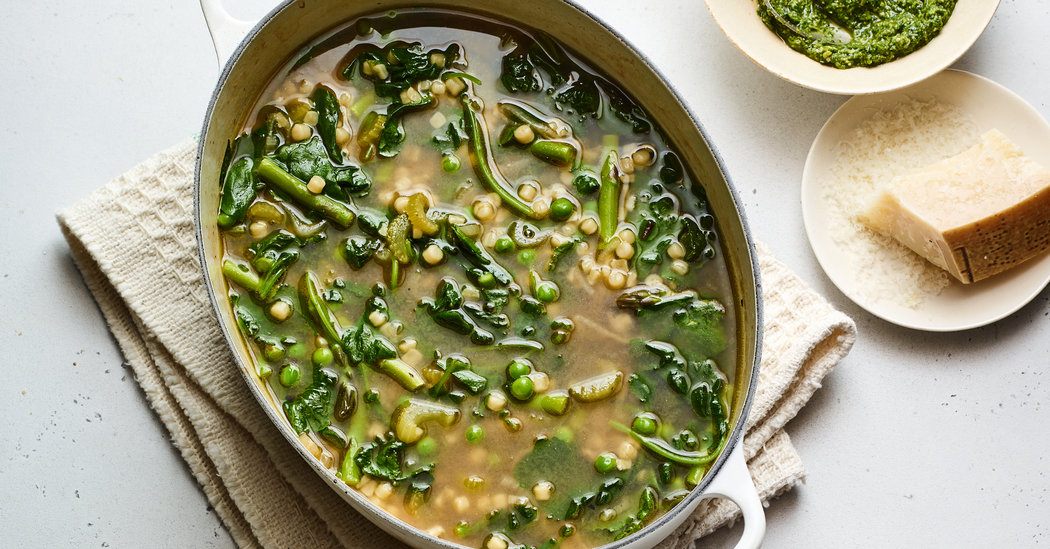During a trip to the grocery store this week, I was stopped in my tracks by my one true harbinger of warmer days to come: the arrival of ranunculus, a darling of spring and my favorite blooms, in the floral section.
It is also, coincidentally, “false spring” here in New York, with temperatures tipping into the 60s yesterday and again next week. And although we are still three weeks out from true spring in the Northern Hemisphere, 7 p.m. sunsets are back in roughly 10 days. Not that I’m counting. (Reader, it’s the only thing getting me from one day to the next.)
Even if it’s not quite spring, I encourage you to eat as if it is: Eat as if it’s bike-shorts degrees outside, as if window boxes are bursting with daffodils, as if your market tote runneth over with asparagus and rhubarb and radishes and young lettuces.
While it might be a touch too soon for David Tanis’s gorgeous spring salad (bookmark it!), sugar snap peas are generally available year-round for Melissa Clark’s hot and sour seared tofu, though her recipe works well with any vegetable cut into small pieces. And in Ali Slagle’s crispy rice with dill and runny eggs, you can use frozen fava beans — or lima beans, or edamame — for a bit of springtime flair.
Ali’s spring barley soup and Kay Chun’s spring minestrone with kale and pasta (above) are ideal shoulder-season recipes, warming and cozy yet verdant and lively. And they’re flexible, too. If you’re not yet wowed by the asparagus in the produce aisle, add sturdy collard greens instead, or hearty edamame, or oniony leeks. Don’t skip the peas, though. They’re almost always better frozen anyway, a cheat code to spring vibes year-round.
Spring Minestrone With Kale and Pasta
Add peas to your pasta too, while you’re at it. Hana Asbrink’s crème fraîche pasta with peas and scallions is a weeknight marvel, bold with plenty of lemon zest.
Or give this 30-minute pasta from Ali a spin. Like Kay’s minestrone, it leans on not one, but two shortcuts to springy eating: frozen peas and pesto. Where Kay uses a store-bought pesto, Ali opts for a quick chopped pesto, which doesn’t require any sort of gadget. (Buy a pesto or use a Parmesan expressly labeled vegetarian if your diet necessitates it. More on cheese-making and rennet at the bottom of this previous newsletter.)
But don’t rush to make all of those in the next week. If Punxsutawney Phil — and my grocery store ranunculus — is to be believed, we’ll be eating like this for months to come.
Crème Fraîche Pasta With Peas and Scallions
One More Thing!
Let’s try something new down here.
Reading: If you’ve ever wondered why peas are among the most consistently reliable frozen vegetable, my colleague Kenji López-Alt had a thorough explanation last week in his new column, Ask Kenji:
“One reason is freshness. Over time, enzymes will naturally convert some of the sugars in peas into starches, making them dull and mealy. Frozen peas — and many other frozen foods — are typically blanched soon after harvest when they’re at their best, destroying those enzymes, and then frozen immediately after, locking those sugars in place until you defrost them.”
Listening: Last month, I picked up Teddy Pendergrass’s 1980 album “TP” for $6 at a record store, and I begin and end every day with it. But I’m particularly fixated on this live version of “Love T.K.O.” performed in London in 1982, one month before the car accident that paralyzed him.
Watching: “Love Is Blind,” like seemingly everyone else you know. Julia Jacobs and Matt Stevens spoke to the show’s producers last year about the nightmarish pods: “Daters are provided meals and can order food to the pods … and while the alcohol supply is ample (the fridge in the lounge is stocked with champagne, beer, wine and hard seltzer), everyone decides for themselves whether they want to drink.”
Thanks for reading (and watching, and listening). See you next week!
Email us at theveggie@nytimes.com. Newsletters will be archived here. Reach out to my colleagues at cookingcare@nytimes.com if you have questions about your account.







